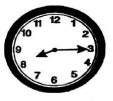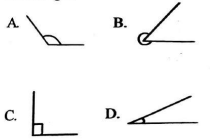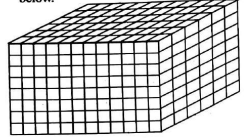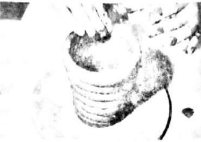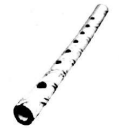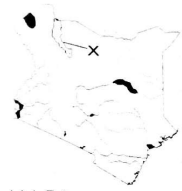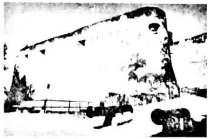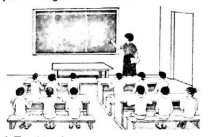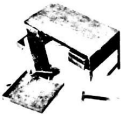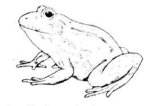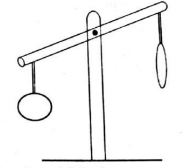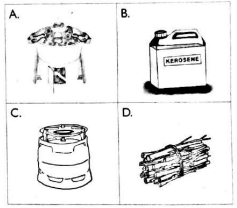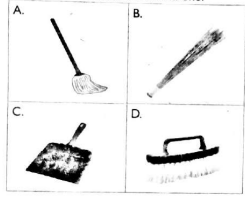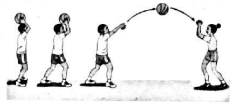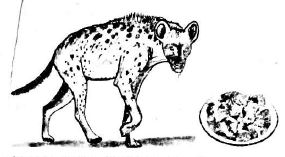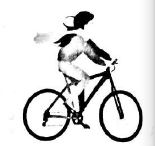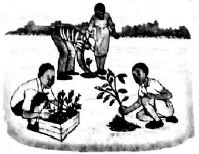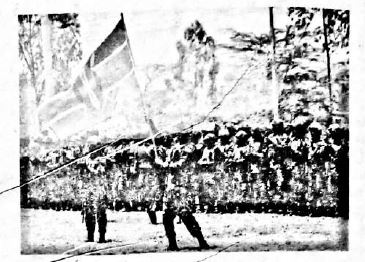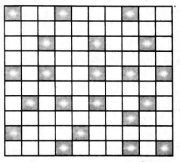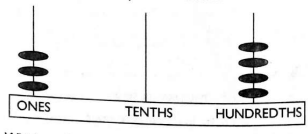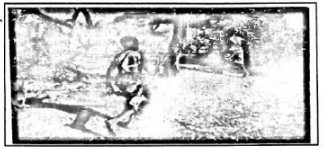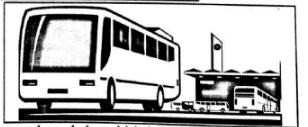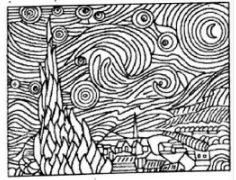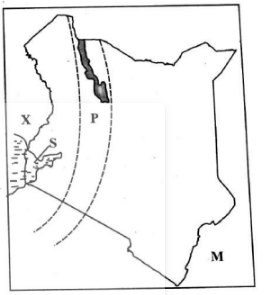Displaying items by tag: grade 5
Kiswahili Lugha Questions and Answers - Grade 5 End Term 1 Exams 2023 Set 3
Soma kifungu hiki Cha mazungumzo kisha ujibu swali la 1-5.
Onyango: Sabalkheri Lucia?
Lucia: Aheri Onyango. Habari za likizo?
Onyango: Njema sana, labda yako.
Lucia: Yangu pia ilikuwa njema. Wakati wa likizo wavyele wangu walinipeleka kwa nyanya.
Onyango: (Kwa furaha) Inaonekana kuwa likizo yako ilijawa na mema.
Lucia: Naam! nyanya alinisimulia hadithi chungu nzima za kusisimua. Baada ya kila hadithi ningepata
mafunzo mengi.
Onyango: Nami ningependa kujua mafunzo uliyopata.
Lucia: Ngano ya sungura na fisi ilinifunza umuhimu wa kushirikiana na wengine.
Onyango: (Huku akitikisa kichwa) Likizo ijayo nami pia nitahakikisha nimeenda kumzuru nyanya.
Lucia: Hakika sahibu yangu. Hilo ni wazo zuri sana. Naomba kwenda darasani. Kuwa na siku njema.
Onyango: Nawe pia Lucia.
Maswali
- Sabalkheri ni salamu za wakati upi?
- Jioni
- Wakati wowote
- Adhuhuri
- Asubuhi.
- Onyango na Lucia walipatana lini?
- Kwa nyanya yao
- Wikendi
- Baada ya likizo
- Disemba.
- Taja hadithi moja iliyotajwa kwenye kifungu hiki
- Onyango na Lucia.
- Nyanya na Lucia.
- Sungura na fisi.
- Nyanya na wavyele.
- Tambua kisawe cha 'wavyele' kama ilivyotumika kwenye mazungumzo
- Mama
- Wazazi
- Abu
- Rafiki.
- Lucia alifurahia nini alipokuwa kwa nyanya yake kulingana na kifungu?
- Hadithi za nyanya.
- Kulisha mifungo.
- Kupalilia mimea.
- Kupiga deki.
Soma kifungu hiki kisha ujibu swali la 6-10.
Dawa za kulevya pia huitwa mihadarati. Dawa hizi huwa na madhara mengi hasa kwa siha zetu. Dawa hizi husababisha vifo pia. Hivyo basi, tunapaswa kuepuka matumizi ya dawa hizi kabisa.
Baadhi ya njia za kuepuka matumizi ya mihadarati ni kusikiliza na kufuata ushauri tunaopewa shuleni na walimu wetu. Walimu huwashauri wanafunzi kuhusu madhara ya dawa za kulevya na jinsi ya kujiepusha na dawa hizi. Mwanafunzi pia anaweza kuingizwa katika matumizi ya dawa hizi na marafiki wapotovu. Ni vyema wanafunzi kuwachagua marafiki wao kwa uangalifu sana.
Wanafunzi pia hawapaswi kutazama filamu na vipindi vinavyopotosha mitandaoni. Vipindi hivi huonyesha wanaotumia dawa hizi kama mashujaa na ni kinyume na maadili.
Hatimaye vijana wanahimizwa kujihusisha na shughuli na michezo mbalimbali wakati wao wa mapumziko ili kujiepusha na fikra za kutaka kujaribu dawa hizi.
Maswali
- Kulingana na aya ya kwanza mihadarati ni nini?
- Dawa za afya.
- Dawa za kulevya.
- Dawa za nguvu.
- Dawa mbovu.
- Ili wanafunzi wajiepushe na matumizi ya dawa za kulevya, wanafaa kufuata ushauri wa nani?
- Mwalimu
- Marafiki
- Rika
- Mitandao.
- Wanafunzi hutazama wapi vipindi na filamu zinazohusu dawa za kulevya?
- Nyumbani
- Shuleni
- Mtandaoni
- Vitabuni.
- Ipi kati ya njia hizi itasaidia kuepuka matumizi ya dawa za kulevya?
- Kusikiliza ushauri wa mwalimu.
- Kuwa na marafiki wapotovu.
- Kutazama filamu na vipindi vinavyoimarisha matumizi ya dawa za kulevya.
- Kutumia muda wa mapumziko kutumia dawa za kulevya.
- Tambua mada inayofaa zaidi kwa kifungu hiki
- Dawa za kulevya.
- Maafa ya dawa za kulevya.
- Wanafunzi na dawa za kulevya.
- Ushauri.
Soma kifungu hiki kwa makini kisha ujibu Swali la 11-15.
Mapambo ni vitu vinavyovaliwa mwilini ili kufanya mtu awe wa kuvutia. Mapambo huvaliwa katika sehemu mbalimbali za mwili. Kuna mapambo ambayo hutumiwa kwa kupaka. Mapambo hasa hutumiwa mtu anapohudhuria sherehe kama za harusi na kadhalika.
Kuna mapambo ya aina mbalimbali ya kike na kiume. Aidha kuna mapambo kama vile ushanga, pambo ambalo huvaliwa na wanawake shingoni. Mapete na vipuli huvaliwa sikioni na wanawake. Pete huvaliwa kwenye kidole cha pete na wanawake kwa wanaume. Hina nayo hupakwa mikononi na miguuni. Ni vizuri kuyatumia mapambo ifaavyo.
Maswali
- Kwa nini watu hutumia mapambo?
- Ili kuvutia
- Ili kusafiri
- Ili kulala.
- Ili kuchukiza.
- Mapambo hutumiwa kwa kuvaa na
- kuangalia
- kula
- kupaka
- hakuna.
- Taja pambo linalotumiwa kwa kupaka
- Kipuli
- Hina
- Ushanga
- Mapete
- Pete huvaliwa wapi?
- Shingoni
- Vidoleni
- Puani
- Mkononi.
- Tambua pambo linalovaliwa sikioni
- Mapete
- Ushanga
- Kipini
- Pete.
Soma kifungu hiki kisha ujibu swali la 16-20 ukitumia jibu sahihi
Asubuhi hiyo watu wengi walikuwa ___16___kwenye ___17___cha polisi. Wanawake kwa wanaume walikuwa wakizungumza kuhusu ___18___waliokuwa wakiwavamia usiku na mchana kwenye kijiji chao. Sajini wa polisi aliyekuwa akiyapokea malalamishi ___19___aliyaandika kwenye shajara na kutuliza ___20___wa watu uliojawa na hasira.
| A | B | C | D | |
| 16. | anafika | wakifika | walifika | watafika |
| 17. | kituo | shule | darasa | mahali |
| 18. | watu | watalii | wanakijiji | wezi |
| 19. | zao | yao | wao | yake |
| 20. | umati | mlolongo | tita | halaiki |
Tambua aina za nomino zilizopigiwa mstari.
- Umati wa watu ulihudhuria mkutano.
- Nomino ya wingi.
- Nomino ambata.
- Nomino ya makundi.
- Nomino ya kawaida.
- Ipi ni nomino tofauti kati ya hizi?
Maji, Maua, Manukato, Maziwa- Maua
- Maukato
- Maziwa
- Maji.
- Andika sentensi ifuatayo kwa wingi.
Sabuni ilinunuliwa jana.- Masabuni yalinunuliwa jana.
- Sabuni zilinunuliwa jana.
- Sabuni ilinunuliwa jana.
- Sabuni yalinunuliwa jana.
- Tambua sentensi iliyoakifishwa vyema.
- juma alisafiri Jana
- wanafunzi wamenunua vibati kalamu na vifutio
- Kitabu kipi kilinunuliwa?
- mwalimu amefika shuleni.
- Kamilisha methali ifuatayo.
Asiyesikia la mkuu huvunjika ______________________- mkono
- shingo
- mguu
- guu
Tumia maneno ya heshima.
- Mama ana mimba
- mawe
- mtoto
- mjamzito
- mlevi
- Mtoto anahara
- anatapika
- anaendesha
- anakimbia
- anazama
- Tumia amba- kukamilisha sentensi ifuatayo.
Chakula ____________________ kimepikwa ni kitamu.- ambayo
- ambacho
- ambalo
- ambao
- Tambua ngeli ya neno lililopigiwa mstari.
Chupa imeanguka ikavunjika.- I-ZI
- A-WA
- U-I
- LI-YA
- Mwezi wasaba huitwaje?
- Agosti
- Juni
- Julai
- Aprili.
INSHA
Ufuatao ni mwanzo wa insha. Iendeleze kwa maneno yako mwenyewe huku ukiifanya iwe ya kusisimua zaidi.
Mvua ilinyesha sana siku hiyo. Mimi na rafiki zangu tulikuwa...
MARKING SCHEME
- D
- C
- C
- B
- A
- B
- A
- C
- A
- A
- A
- C
- B
- B
- A
- C
- A
- D
- B
- A
- C
- A
- B
- C
- D
- C
- B
- B
- A
- C
English Language Questions and Answers - Grade 5 End Term 1 Exams 2023 Set 3
Read the story below and answer the questions.
One day Hyena went together with Hare to collect honey in the forest where men used to hang their beehives from the trees. Hare climbed the tree, extracted big lumps of combs full of honey from a beehive, and when he was full, said to the Hyena: 'Open your mouth and I will drop some honey into it'. The Hyena did so and swallowed the honey with great pleasure several times, until she was also satisfied. Then Hare left the tree and returned to the ground.
He asked the Hyena: 'How did you enjoy the honey?" 'Very, very much, my dear friend'. 'But remember', said hare, 'this is a kind of sweetness that must not be evacuated from your body'. 'Yes, I think it must be so; but how can one prevent it from going out?' 'I'll tell you what to do. I will stitch your waist together with your tail and you may be sure that no sweetness will come out'.
Hyena was so excited that he agreed. So, Hare stitched Hyena's waist and went on his way home. After some time, Hyena felt he needed to go for a long call but he could not do it. He lay on the ground in pain until his behind burst spraying stool all over.
Questions.
- Where did Hare and Hyena go to collect honey? The
- shamba
- forest
- river
- hill.
- How did Hare give the honey to Hyena? By
- using a spoon to feed him
- dropping combs into his mouth
- asking him to wait
- chewing and spitting into his mouth.
- How did Hare trick Hyena?
- He told him that the sweetness must not be evacuated.
- He told him to climb the tree.
- He lied to him so he could steal his share of honey.
- He told him to drink water.
- What happened when Hyena felt the urge to evacuate?
- His behind burst open and spread stool all over.
- He got hare to remove the stitches.
- He removed the stitches himself.
- He went to the doctor to have the stitches removed.
- What lesson do we learn from this story?
- We should always do what our friends tell us.
- We should not be foolish and greedy.
- We should eat lots of honey.
- We should not trust anyone.
Read the passage and answer the questions that follow.
Jamie found a hungry boy on the side of the road with dirt across his face. The boy looked fourteen years of age. He didn't speak much. They rode the lonely road together. Fifteen minutes had passed in silence when the boy finally spoke.
'Riley' the boy said and stared ahead. 'Is that your name?' Jamie asked with his deep voice. He didn't answer. He presumed Riley was the boy's name.
'Jamie' he replied. There was a glimpse from the boy, but his look soon returned to the road as he noticed him looking back. The boy, Riley, said something but Jamie was lost in thought. 'Sorry, I didn't catch that,' he said, thinking about his late brother.
'Can we stop here?' the boy requested. Jamie looked around and saw trees, and when the reason crossed his mind, he stopped the car.
The kid opened the door, jumped out of the car, and walked into the wall of trees worry-free. Jamie waited for a while but when he didn't come back, he was worried.
'Riley!' 'Please, stop hiding' 'he heard rustling, looked around and walked towards the sound. He saw Riley sitting on a fallen tree, holding a piece of fabric. When he saw Jamie looking, he hid it in the pocket of his coat. Riley stared at him with big eyes, almost scared. Jamie was so relieved.
Questions.
- Where did Jamie find the boy?
- At the side of the road.
- At the market place.
- In the forest.
- At the river bank.
- How did the boy look when Jamie found him? He looked
- hungry and dirty
- happy
- angry
- confident.
- Where did the boy go when he got out of the car? He went
- back to the market
- into a wall of trees
- home
- to another house
- What was Jamie thinking about when the boy talked to him? He was thinking about
- his late brother
- going to a hotel
- what he was going to do with the boy
- returning to town.
- How old was the boy? Approximately
- sixteen years
- twelve years
- nine years
- fourteen years.
Read the story below and answer the questions that follow.
Informal education in the traditional African society was conducted by elders. Youth were gathered together to learn, mostly in huts and under trees. Education of girls was done separate from the boys'. Children were gathered in their grandmothers' huts and were told stories designed to caution them against certain behaviours.
The girls were taught by their mothers and grandmothers. They were taught how to cook, care for their husbands and children. They were also taught how to farm and produce enough food for the family. Boys on the other hand were taught by their fathers and grandfathers.
They mostly took care of livestock and were also taught the secrets of the tribe. Boys were also taught to be the providers and heads of the family.
Questions
- Who conducted education in traditional African society?
- Elders
- Children
- Youth
- Ancestors.
- What were girls taught about?
- How to take care of livestock.
- The secrets of the tribe.
- How to cook.
- How to fight.
- The following are lessons boys were taught. Which one is not?
- How to take care of livestock.
- The secrets of the tribe.
- How to be good husbands and heads of the family.
- How to cook.
- Where did learning in traditional African society take place?
- In the classrooms.
- In huts and under trees.
- At the farms.
- In the kitchen.
- Why do you think education of girls was separated from that of boys?
- Because they were afraid girls would defeat the boys.
- Because the lessons for each group were different.
- Because they did not want the two groups to interact.
- Boys liked playing much with their fathers only.
Fill in the blank spaces 16-25 by using the best answer.
Personal hygiene ___16___ a practice ___17___ should observe ___18___. Lack ___19___ proper hygiene can ___20___ to problems such as skin ___21___. We should practice personal hygiene by bathing ___22___ and wearing ___23___ clothes. Doing ___24___ will keep us healthy ___25___ strong.
| A | B | C | D | |
| 16. | is | was | has | have |
| 17. | them | me | you | your |
| 18. | regularly | never | mostly | almost |
| 19. | with | of | at | on |
| 20. | make | result | lead | go |
| 21. | marks | diseases | blemishes | problems |
| 22. | never | weekly | seldom | everyday |
| 23. | dirty | clean | torn | ragged |
| 24. | so | that | with | okay |
| 25. | again | both | plus | and |
For the following questions, choose the correct answer from the choices given.
- Yvonne ____________________ on the notice board yesterday.
- wrote
- writted
- written
- write
- Maria is ______________________ in English than me.
- good
- better
- gooder
- best
- Only _____________________ people will be allowed in the room because it is small.
- little
- a few
- many
- few
- He is not coming back, ___________________?
- isn't it
- isn't he
- is it
- is he
- She is the class representative _____________________she is always involved in indiscipline cases.
- yet
- because
- and
- although
COMPOSITION
Write an interesting composition about:
MY FAVOURITE PET
MARKING SCHEME
- B
- B
- A
- A
- B
- A
- A
- B
- A
- D
- A
- C
- D
- B
- B
- A
- C
- A
- B
- C
- B
- D
- B
- A
- D
- A
- B
- D
- D
- A
Mathematics Questions and Answers - Grade 5 End Term 1 Exams 2023 Set 3
QUESTIONS
- In a certain county, there are eighty nine thousand and sixteen people. What is the number of people written in symbols?
- 8916
- 89016
- 890016
- 916
- Which digit is in the thousands place value in the number 780462?
- 4
- 6
- 0
- 8
- In the year 2020, the number of pupils who sat for KCSE exam was 934607 candidates. What is the total value of digit 9 in the number given?
- 900000
- 9000
- 90000
- 9000000
- In a Game Park, the number of Zebras, Warthogs, Antelopes, Gazelles and Elephants are: 8964, 8046, 9649, 9924 and 7648 respectively. Arrange the numbers in ascending order.
- 7648, 8046, 8964, 9649, 9924
- 9924, 9649, 8964, 8046, 7648
- 7648, 8964, 8046, 9924, 9649
- 8964, 7648, 8046, 9649, 9924.
- A school fenced its compound using 6397 posts. What is this number of posts rounded off to the nearest thousand?
- 6390
- 7000
- 6000
- 6300
- An ATM machine reads the following numbers on daily occurrences. Which one of the following groups of numbers is divisible by 10?
- 80, 76, 33, 70
- 60, 49, 65, 90
- 13, 20, 50, 35
- 20, 50, 40, 70,
- The following are ages of different people in a certain locality. Which one of the following numbers is not a common multiple of 6 and 8?
- 72
- 48
- 64
- 248.
- A teacher wrote numbers 45 and 60 on the chalkboard. He told learners to calculate the LCM of the two numbers. What was the correct answer?
- 180
- 360
- 450
- 240
- The number of students who joined universities in one year was 366311. The following year, the number was 36428 students. How many students joined university in the two years?
- 403639
- 329783
- 330783
- 402739
- A teacher wrote the pattern: 121400, 131400, 141400, and 151400. She asked her learners to get the next num- ber. What was the number?
- 161400
- 162400
- 153400
- 160400
- Peter got 9/10 in English. Write the marks he got as a decimal?
- 9
- 9.0
- 0.9
- 0.09
- Work out the operation below.
Hrs Mins
3 45
+5 20.
________________- 8hrs 65mins
- 9hrs 5mins
- 8hrs 5mins
- 9hrs 65mins
- A shopkeeper packed 10kg of sugar in 1/4Kg packets. How many packets did he make?
- 40
- 6
- 3
- 12
- Juma woke up at the time shown on the clock face. What time did he wake up?
- 8:15 pm
- 8:03 pm
- 8:15am
- 8:03am
- A shopkeeper had a Sh. 500 note. She changed the money into Sh. 50 notes. How many notes did she get?
- 10
- 8
- 5
- 4
- A teacher had y pencils. He shared the pencils among four girls. If each girl got 5 pencils, how many pencils had he at the beginning?
- 20
- 24
- 9
- 15
- Which among the following is an acute angle?
- A member of parliament gave of the money collected during a fundraising ceremony to the needy for fees. What is the simplest form of the fraction?
- 3/4
- 4/12
- 7/12
- 3/12
- A teacher wrote the following on a number card. Fill in the missing number.
- 21
- 20
- 40
- 12
- Rosemary had Sh. 1050. She bought 1kg of cooking fat worth Sh. 599. How much balance did she receive?
- Sh. 1109
- Sh. 450
- Sh. 1649
- Sh. 451
- Arrange the fractions 2/3, 1/6, 1/2, 1/8 from the largest to the smallest.
- 1/8, 2/3,1/6, 1/2
- 2/3, 1/2, 1/6, 1/8
- 1/2, 1/6, 1/8, 2/3,
- 2/3,1/6, 1/8, 1/2
- Maria took 120 minutes to fetch water from the river and back to her home. How many hours did she take?
- 2 hrs
- 12 hrs
- 4 hrs
- 10 hrs
- In a school hall, there are 246 benches. Each bench is used by 12 learners comfortably. How many learners can sit on all benches?
- 258
- 234
- 2952
- 2950
- A tank had 5050.072 litres of water. After one week, 1020.069 litres had been used. How much water was
remaining in the tank?- 6070.072L
- 4030.003L
- 4930.03L
- 5070.072L
- The distance from the Chief's camp to the dispensary is 3400 m. What is the distance in Kilometers?
- 340000 km
- 3400 km
- 34 km
- 3.4 km
- A square measures 12 cm by 12 cm. What is its area?
- 144 cm2
- 164cm2
- 24 cm2
- 414 cm2
- Packets in the shape of 1 cm cubes were arranged and filled a carton as shown below.
What was the volume of the carton?- 467cm3
- 570 cm3
- 26cm3
- 576 cm3
- The length of a room is 10 metres. What is the length of the room in centimetres?
- 100 cm
- 10000 cm
- 1000 cm
- 0.1 cm
- A shopkeeper had 42 kg 100g of flour. She sold 32 kg 400g of the flour. What mass of the flour remained?
- 9 kg 700g
- 10 kg 300g
- 9 kg 300g
- 5 kg 200g
- Juma prepared 5000 milliliters of juice. What is the capacity of the juice in litres?
- 50L
- 500L
- 5.5L
- 5L
MARKING SCHEME
- B
- C
- A
- A
- C
- D
- C
- B
- D
- A
- C
- B
- A
- C
- A
- A
- D
- A
- B
- D
- B
- A
- C
- B
- D
- A
- D
- C
- A
- D
Creative Arts, Social Studies & Religion Questions and Answers - Grade 5 End Term 1 Exams 2023 Set 2
SECTION 1: ART AND CRAFT.
- Which one of the following is not an element of art?
- Line
- Texture
- Colour
- Form
- The shading technique used in the picture below is called _____________________
- crayon etching
- stippling technique
- smudging technique
- cross hatching
- Which one of the following is not required when making crayons from locally available materials?
- Bee wax
- Moulding paper
- Colour pigments
- Water paints
- The following materials can be used to scratch off ink or paint in crayon etching except a ______________
- nail
- toothpick
- pointed pen
- soft cloth
- _________________________is the process of using paint or ink to make a picture.
- Weaving
- Stitching
- Colouring
- Painting
- Which one of the following is not suitable textured material for making a collage artwork?
- Sand grains
- Grass cuttings
- Small sized leaves
- Broken glass
- When making a collage artwork, adhesives are used for _________________________.
- decoration
- mounting
- sticking or pasting
- colouring
- Mixing yellow and blue colours in equal proportion results in _____________ colour.
- purple
- green
- yellow
- orange
- Which one of the following statements is not true?
- Mixing two primary colours results in a secondary colour
- We mix primary and secondary colours to create a tertiary colour
- There are four primary colours
- Mixing red and orange creates a red- orange colour
- Which one of the following is a source of natural fibres used in weaving?
- Banana fibres
- Polythene fibres
- Old clothes
- Acrylic fibres
- Interlacing a set of vertical threads (warps) with horizontal threads (wefts) is called _______________
- painting
- Weaving
- drawing
- basketry
- Alpha made a pencil case from recycled leather. Which would be the best way for him to decorate it?
- Beading
- Painting
- Weaving
- Carving
- Which tool is required to make holes on leather to enable a person join different pieces with thongs?
- Leather punch
- Pliers
- Carving knife
- Adze
- Which of the following is not a way in which stiff weaving materials can be prepared for weaving?
- Stripping
- Cutting
- Shredding
- Coiling
- The following picture shows the ______________________technique in pottery.
- slab
- coil
- pinch
- modelling
SECTION 2: MUSIC
- Which of the following is not an element of folk dance?
- Body adornment
- Ornaments
- Costumes
- Message
- Who are considered participants in a folk dance?
- Soloist
- Dancers
- Audience
- Instrumentalist
- How do people express themselves when singing?
- By sleeping
- By whistling
- By using facial expressions
- By singing
- Which one is an importance of a folk song?
- They cause problems.
- They bring people together
- They make people sad
- They do not communicate the culture
- Which one is not an example of an African wind instrument?
- Abu
- Coro
- Trumpet
- Bungó
- How many holes does the instrument below have?
- 7
- 6
- 3
- 8
- Which one is not part of a wind instrument?
- Pitch holes
- Strings
- Mouth piece
- Neck
- What is the name of the note
 ?
?- Semibreve
- Quaver
- Minim
- Crotchet
- What is the rest symbol for a minim
- What is the note value for a crotchet?
- 1/2
- 1/4
- 1
- 1/8
SECTION 3: SOCIAL STUDIES.
- Map interpretation means giving ______________________ to the features and symbols used on a map.
- meaning
- elements
- reading
- interpretation
- Communication is represented on a map by use of ________________________.
- Quarry
- Telephone mast
- Police post
- Market
- Kenya is surrounded by neighbouring countries. It is surrounded by Uganda to the ___________________.
- East
- West
- North
- South
- Who represents Kenya in other countries to promote good relations?
- Member of Parliament
- President
- Ambassador
- Cabinet secretary
- Which drainage feature is labelled X on the map below?
- Lake Turkana
- Lotikipi swamp
- Lake Bogoria
- Lake Magadi
- The people of Kwale, Taita and Taita areas receive rainfall of not above 1000mm per annum. Name the climatic region that covers these regions.
- Desert climate
- Tropical climate
- Mountain climate
- Modified equatorial climate
- The historical building shown below is located in _________________.
- Nairobi
- Mombasa
- Nakuru
- Meru
- Nilotes are believed to have originated from ____________while Bantus originated from ____________
- Ethiopia, Kenya
- Horn of Africa
- Barh-el-Ghazal, Congo forest
- Somalia, Sudan
- Chalbi desert is _________________populated.
- sparsely
- densely
- nucleated
- clustered
- The following are methods of instruction used in African traditional education except.
- Stories and narratives
- Apprenticeship
- Ceremonies
- Vising the sick
- Barry has been elected in school as the president. Which of the following is not one of his duties to perform?
- Provide feedback to the administration concerning student affairs.
- He is a role model to other learners.
- Does not link learners with administration.
- Supervises school activities.
- Identify the duty that the teacher is performing as shown below.
- Teaching learners.
- Preparing a school time table.
- Admitting new learners.
- Recording minutes of the staff meeting.
- Most of the desks in Tusome Primary School need to be repaired. Who is in charge of repair and maintenance of school property?
- Senior teacher
- Head teacher
- School clerk
- Class teacher
- Children are expected to portray the following values except
- Hard work
- Honesty
- Disrespect
- Patience
- Marriage ceremonies help communities to bring ___________________.
- Knowledge
- Peace and unity
- Bride prize
- Favouritism
SECTION 4:
CHRISTIAN RELIGIOUS EDUCATION.
- Who were the first people to be created by God?
- Abraham and Sarah
- Adam and Eve
- Moses and Miriam
- Jacob and Leah
- Which sin did the first human beings commit?
- Adultery
- Disobedience
- Murder
- Stealing
- Which of the following activities promotes family unity?
- Praying together
- Burdening one person with house chores.
- Holding grudges when conflicts occur
- Not correcting one another when we are wrong
- Which of these values can we use to nurture our talents and abilities?
- Laziness
- Fear
- Honesty
- Irresponsibility
- Which of the following is a way of obeying rules
- Destroying the environment
- Saving water
- Leaving lights on
- Being disorderly in school.
- Which of the following activities does not show good stewardship?
- Planting trees in the community
- Polluting rivers in the community
- Taking care of domestic animals
- Collecting litter from the environment
- Which of these values is not taught by the parable of the talents?
- Loyalty
- Disobedience
- Respect
- Responsibility
- Which one of the following is not true about a Christian marriage?
- Bride price is paid
- It is for company
- It is permanent
- Divorce is allowed
- Which of these values can we learn from the fall of human beings?
- Laziness
- Fear
- Obedience
- Irresponsibility
- Which of the following is not a cause of child labour?
- Poverty
- Death of parent or guardian
- Wealth
- Irresponsible parents
SECTION 4:
ISLAMIC RELIGIOUS EDUCATION.
- Iddul-fitr comes after the month of __________________________
- Ramadhan
- Shawwal
- Rajab
- Muharram
- Urine of a baby who is less than two years is __________________.
- Muhaffafah
- Mughalladhah
- Mutawasit
- Hadath
- Allah (SWT) created us so that we may ______________________.
- Become rich
- Enjoy life
- Worship Him
- Obey parents
- Astaghfirullah' is said when a msuslim
- Sneezes loudly
- Wakes from sleep
- Visits the toilet
- Ask for forgiveness
- The journey of the prophet (OPBUH) to Madinah was called ___________________
- Miraj
- B.Hijra
- ls-ra
- Muhajirun
- Which of the following is common among Muslims?
- Food
- Quran
- Colour
- Names
- One of the follwoing words is not in suratul Takathur. Which one?
- Faumuhu
- Naiim
- Maqaabir
- Al-yaqiin
- The old name for Madina is
- Misr
- Sham
- Makkah
- Yathrib
- Fasting is like a ________________
- Sword
- Spear
- Shield
- Prayer
- The night of power is called
- Lailatul Miraj
- Lailatul Qadr
- Lailatul Noor
- Lailatul Isra
MARKING SCHEME
ART
- C
- D
- D
- D
- D
- D
- C
- B
- C
- A
- B
- A
- A
- D
- B
MUSIC
- D
- C
- C
- B
- C
- A
- B
- A
- D
- B
SOCIAL
- A
- B
- B
- C
- A
- B
- B
- C
- A
- D
- C
- A
- B
- C
- B
C.R.E
- B
- B
- A
- C
- B
- B
- B
- D
- C
- C
I.R.E
- C
- D
- B
- D
- B
- A
- A
- A
- B
- D
Integrated Science Questions and Answers - Grade 5 End Term 1 Exams 2023 Set 2
SCIENCE AND TECHNOLOGY
- Grade 5 learners observed the animal shown below during a nature walk.
Which animal belongs in the same group with the animal shown above?- salamander
- turtle
- chameleon
- gecko
- The following are factors that affect floating and sinking. Which one does not?
- size
- shape
- material
- weight
- How many senses does a dumb person have?
- 3
- 5
- 6
- 4
- Jamila poured water in different containers as shown below.
From the diagram, it can be concluded that;- liquids take the shape of the container.
- liquids have no volume.
- liquids have definite shape.
- liquids have weight.
- A set of instructions that can be followed by a computer are known as;
- code
- digital information
- digital technology
- data
- Zawadi noticed that when he throws a ball against a wall, the ball bounces back. What conclusion can we make from that observation?
- Force can change the shape of an object.
- Force can change the direction of movement.
- Force can stop movement.
- Force can change the size of an object.
- Charleen saw an elephant and its calf eating grass. Which two characteristics of animals could be observed from what she saw?
- animals can feed and grow
- animals can reproduce and grow
- animals can reproduce and feed
- animals can grow and remove waste
- A human being has ___________________ incisors on one jaw.
- 8
- 4
- 2
- 6
- In the breathing system, the other name of the trachea is __________________.
- gullet
- Oesophagus
- windpipe
- food pipe
- The following diagram was obtained during a grade 4 Science and Technology lesson. What conclusion could be obtained from the diagram?
- Gases have definite shape.
- Gases have weight.
- Gases have definite volume.
- Gases have mass.
- Chausiku was unwell with the following signs and symptoms.
- Coughing and chest pains
- Shortness of breath
- Low body temperature
- Feeling tired and trouble breathing
It is likely that Chausiku was suffering from;- asthma
- tuberculosis
- pneumonia
- flu
- Which of the following statements is true about mammals?
- All mammals live on land.
- All mammals reproduce by giving birth.
- All mammals feed the young ones through mammary glands.
- All mammals move by walking.
- Penicillin is important because;
- it can be used as food.
- it can be used as antibiotic.
- it can be used in baking.
- it adds vitamin to the body.
- Reptiles are cold blooded, that means that;
- Their blood remains cold whether the weather is cold, warm or hot.
- Their body temperature remains the same whether the weather is cold, warm or hot.
- Their body temperature remains low when the weather is cold and rises when the temperature is hot.
- Their body temperature remains high when the weather is cold and becomes low when the temperature is hot.
- I am part of the human skeleton. I protect the brain. Who am I?
- ribcage
- skull
- backbone
- limbs
AGRICULTURE
- Which of the following pairs of crops can be grown on the same type of soil?
- Rice and cabbages
- potatoes and sugarcane
- carrots and coconut
- maize and groundnuts
- Learners from Milimani Academy wrote the characteristics of different types of soil as shown below.
- it retains moderate amount of water
- it has large particles
- it retains the highest amount of water
- it has small particles
- It has moderate soil particles
- Iit retains the lowest amount of water
Which pair of characteristics refers to soil?- vi, ii
- v, i
- ii, v
- iv, iii
- The following are the steps of preparing seeds for planting.
- washing and cleaning the seeds
- drying the seeds
- removing the seeds from the fruit
Arrange the steps in the right order.- iii,ii,i
- iii, i, ii
- ii, iii, i
- i, iii, ii
- Which of the following statements is not true about mulching?
- It controls weeds on the farm.
- It increases the rate of evaporation on the land.
- It causes high growth rate of crops.
- It helps to ensure high moisture content.
- It is true that the soil that is carried away during soil erosion;
- is of no importance in farming.
- has no nutrients.
- can be recovered.
- cannot be recovered.
- Learners from Mpeketoni Primary school went to recover soil that had been deposited on the fence of the school. What should they use to carry the soil back to the farm?
- wheelbarrow
- spade
- tractor
- small tins
- The settling of eroded soil on certain land sites is known as __________________.
- soil erosion
- soil deposition
- soil recovery
- soil improvement
- Grade 5 learners from Emuberi Academy wanted to identify the farm that needed soil improvement. How would they identify the farm?
- They should improve the farm that produces high yields.
- They should improve the farm that is highly fertile.
- They should improve the farm with healthy crops.
- They should improve the farm with unhealthy crops.
- The following are examples of organic waste that can be used in an organic waste pit except;
- kitchen waste
- factory waste
- animal waste
- crop remains
- Which of the following statements is true about shading.
- It hardens the crops before transplanting.
- It ensures that a few healthy crops remain in the nursery.
- It is a source of plant nutrients.
- It prevents excessive water loss from the soil.
- Which of the following statements is true about an organic waste pit?
- Crops are grown on it after removing therotten waste.
- All kitchen waste can be put in it.
- Crops are grown on it when the waste is fully rotten.
- It cannot be constructed if we don't have kitchen waste.
- The following are ways of conserving water on the farm. Which one is not?
- irrigation
- shading
- cover cropping
- mulching
- Which of the following small animals can be controlled by fencing the farm?
- mole
- weaverbird
- mongoose
- eagle
- Which one of the following statements is true?
- It is not advisable to apply ash on the compost manure.
- The compost manure materials should be kept moist by sprinkling water on it.
- The compost manure materials should be rained on.
- The compost manure will be ready after three weeks.
- ____________________ is the excess water that runs on the surface.
- soil erosion
- rain water
- run off
- water conservation
HOME SCIENCE
- Which of the following practices helps to prevent the spread of diseases to other people?
- Washing hands after visiting the toilet or latrine
- Eating well cooked food
- Washing hands before eating
- Covering the mouth when coughing
- Identify the most common fuel in the village.
- ______________________ is removal of dust using a vacuum cleaner.
- dusting
- suction
- brushing
- mopping
- Which fuel can be used to cook, heat or warm the house and provide light?
- charcoal
- gas
- electricity
- paraffin
- Which of the following practices may cause cholera?
- walking in the cold
- drinking dirty water
- not having a balanced diet
- taking a lot of sugar
- Arrange the following steps of cleaning shoes in the right order.
- Rinse the shoes well in clean water.
- Dry the shoes in the shade.
- Dip the shoes in the soapy water.
- Scrub the shoes using a cloth or a soft brush.
- Remove any mud from the soles using a blunt stick.
- v, iii, iv, i, ii
- iii, v, iv, i, ii
- iii, iv, v, i, ii
- v, iii, i, iv, ii
- Which one of the following equipment should not be used to cook when doors are closed?
- paraffin stoves
- charcoal jiko
- gas cooker
- electric cooker
- Which of the following refers to the last step of cleaning a house?
- Gather dust together and collect using a dustpan
- Collect all required equipment and materials
- Close windows and doors
- Rearrange room and open windows and door
- The following are equipment used in the house. Which of them is the odd one?
- Which one of the following rooms is the largest in the house?
- dining room
- bedroom
- living room
- kitchen
PHYSICAL HEALTH EDUCATION
- A relay batons should not be;
- light in weight
- easy to carry
- easy to see
- heavy in weight
- In the game of Rounders, hitting the ball from the frontline of the batting square by the player to the direction he or she chooses is known as;
- fielding
- gripping
- bowling
- batting
- Identify the first step in performing a forward roll.
- tuck the chin and head towards the chest
- squat
- roll forward
- stand without using your hands for support
- The normal heartbeat of an adult is ________________beats per minute.
- 30-50
- 100-150
- 10-40
- 60-100
- Before a sporting activity, grade 4 learners were asked to observe safety precautions during the activity. This is because;
- It ensures that the sporting equipment is safe.
- It entertains the spectators.
- It helps to ensure personal safety.
- It ensures victory during the activity.
- __________________is touching a post by the fielder using the hand with the ball.
- stamping
- batting
- fielding
- catching
- The skill shown below is known as;
- overhead throw
- underarm throw
- chest pass
- overarm pass
- Which one of the following games is not related to the rest?
- rounders
- baseball
- softball
- tennis
- In rounders, if the batter reaches 2nd or 3rd post in one hit. The team scores _________________.
- 2 rounders
- half a rounder
- one rounder
- quarter a rounder
- Field events are divided into _________________ and __________________.
- sprints and long races
- races and throws
- sprints and jumps
- jumps and throws
MARKING SCHEME
- A
- A
- B
- A
- A
- B
- C
- B
- C
- D
- C
- C
- B
- C
- B
- A
- A
- A
- B
- C
- A
- B
- D
- B
- D
- C
- A
- C
- B
- C
- D
- D
- B
- C
- B
- A
- B
- D
- C
- C
- D
- D
- B
- D
- C
- A
- A
- D
- B
- D
Shughuli za Kiswahili Questions and Answers - Grade 5 End Term 1 Exams 2023 Set 2
MAAGIZO
Karatasi hii ina sehemu tano kuu.
Jibu maswali yote kulingana na maagizo.
Soma kifungu kifuatacho kisha ujibu maswali yanayofuata.
Fisi na wenzake walialikwa katika sherehe kubwa kule mjini. Pamoja na Fisi, wanyama wengine walioalikwa walikuwa Sungura, Ndovu na Nyoka. Sherehe hiyo ilikuwa ya harusi kati ya Chui na Kondoo. Walipofika katika sherehe hiyo, walipata sherehe ilikuwa imeanza. Baada ya nyimbo kuimbwa, wakati wa kuunganishwa ulifika. Chui na Kondoo walitangazwa kuwa mke na mume. Shangwe na kelele zilisikika hewani. Hatua iliyofuata ilikuwa ya kufurahia mlo. Huo ndio wakati ambao fisi alikuwa amesubiri kwa hamu. kuu.
Jambo lililomfurahisha fisi kabisa ni kuwa kila mmoja alipewa nafasi ya kujipakulia. Fisi alijaza sahani yake kwa nyama za kila aina: kuku, mbuzi, samaki, ng'ombe. Pia alichukua matunda na mboga. nyingi sana ingawa hakupenda kula mboga na matunda. Hata kabla ya kuanza kula, kelele zilisikika kuwa moto ulikuwa ukiwaka katika nyumba hiyo. Wanyama wengine wote walianza kutoroka. Fisi alishangaa iwapo alifaa kuacha chakula ama aendelee kula. Aliendelea kufurahia vipande vya nyama huku akiramba vidole. Mara moto ulikuwa umemfikia. Alipiga kelele lakini moto ulikuwa umemfikia. Ingawa aliweza kutoka nje, miguu yake ya nyuma ilichomeka.
- Ni nini kilichofanyika kabla ya Chui na Kondoo kutangazwa kuwa mke na mume?
- Moto ulianza kuwaka
- Shangwe na kelele zilisikika
- Chakula kilianza kuliwa
- Nyimbo ziliimbwa
- Kifungu kinaeleza kuwa wanyama katika sherehe hiyo walikuwa aina wangapi?
- 4
- 6
- 5
- 7
- Kisa hiki kinaeleza sababu ya;
- fisi kupenda kula.
- miguu ya fisi kuwa mifupi.
- fisi kutojua kukimbia.
- fisi kutopenda nyama.
- Kutokana na kisa hiki, tunajifunza kuwa;
- tusiende sherehe.
- wanyama wasikusanyike pamoja.
- tamaa ni mbaya.
- chakula kisiliwe katika harusi.
- Lengo kuu la fisi kuhudhuria sherehe lilikuwa gani?
- kufurahia nyimbo
- kufurahia harusi
- kukutana na wenzake
- kufurahia chakula
- Methali gani inayoweza kueleza kisa hiki?
- Tamaa mbele mauti nyuma.
- Polepole ndio mwendo.
- Mtoto umleavyo ndivyo akuavyo.
- Achanikaye kwenye mpini hafi njaa.
Soma makala yafuatayo kisha ujibu maswali yanayofuata.
Siku moja wakati wa likizo ya muhula wa kwanza, Kalondu aliamshwa asubuhi na mapema. Kwa kuwa Kalondu hakuenda shuleni, mama yake alimpa maagizo kabla ya kutoka. Mama yake alikuwa akienda sokoni Butere ambako aliuza vyombo mbalimbali vya kutumia jikoni. Kabla ya kutoka, mama yake alimwambia kuwa asitoke nyumbani. Hii ni kwa sababu wezi wangeingia nyumbani kwao na kuiba vitu katika nyumba. Pili aliambiwa kuwa asitumie kifaa chochote cha kidijitali kuingia mtandaoni bila idhini ya mama yake.
Mama alimwacha akinywa chai pale sebuleni huku akitazama vibonzo kwenye runinga. Kalondu alipomaliza kunywa chai, alishindwa cha kufanya. Alitoka nje ya nyumba na kuona kuwa watoto wengine walikuwa wakiendesha baiskeli njiani. Alijipenyeza polepole na kutoka nje ya boma. Watoto hao walimpa baiskeli na kumwambia kuwa asiendes he haraka. Kalondu alianza polepole lakini baada ya muda kidogo aliendesha haraka sana. Mara alianguka chini kwenye jiwe. Kalondu aliumia goti lake na mkono.
- Kwa nini Kalondu hakuwa ameenda shuleni siku hiyo?
- mama yake alimkataza
- mama yake alitaka kuenda sokoni
- ilikuwa siku ya Jumamosi
- ulikuwa wakati wa likizo
- Kwa nini mama alimshauri Kalondu asitoke nyumbani?
- Ili wezi wasiingie nyumbani kwao na kuiba
- Ili asiumie wakati akiendesha baiskeli
- Ili asipotee akiwa peke yake
- Ili asaidie kufanya kazi za nyumbani
- Unadhani kwa nini mama hakutaka Kalondu atumie kifaa cha kidijitali kuingia mtandaoni bila idhini?
- Kwa kuwa ni vibaya kutumia kifaa cha kidijitali
- Kwa kuwa hakiwezi kufanya kazi kama mama hayuko
- Kwa kuwa angejipata kwenye mitandao isiyofaa
- Pengine kifaa hicho kilikuwa kimeharibika
- Ungekuwa Kalondu, ungefanya nini baada ya kunywa chai?
- Ningerudi kulala
- Ningesoma kitabu cha hadithi
- Ningeenda nje kucheza
- Ningeenda jikoni kupika
- Methali gani ambayo haiwezi ikatumika kumshauri Kalondu?
- Harakaharaka haina baraka.
- Asiyesikia la mkuu huvunjika guu.
- Mtoto umleavyo ndivyo akuavyo.
- Pole pole ndio mwendo.
- Yawezekana kuwa mama wa Kalondu aliuza nini kati ya vifaa vifuatavyo?
- kikaango
- baiskeli za watoto
- viti
- vitabu
Soma kifungu kifuatacho kisha ujibu maswali yanayofuata.
Maji yana umuhimu sana katika maisha yetu. Hutumika kufanya mambo mbalimbali maishani. Jambo la msingi ni kuwa maji hutumika katika upishi na kudumisha usafi. Kutokana na hayo, ni jambo la busara kuyatunza maji. Hatufai kuyaharibu maji kwa njia yoyote. Vilevile, tusichafue vyanzo vya maji kama vile mito na bahari. Shughuli kama vile kuoga na kufua hazifai kufanyikia kwenye mito, bahari na maziwa. Uharibifu wa bahari, mito na maziwa huweza kuwaangamiza viumbe wa majini kama vile samaki na kaa. Kila mkenya anafaa kuyajali mazingira yao. Tukihifadhi mazingira, tutaishi maisha bora yasiyokuwa na matatizo mengi.
- Ni kweli kuwa maji hutumika kufanya;
- mambo mengi.
- mambo machache.
- mambo mawili.
- mambo ya mbali.
- Ni keli kuwa maji;
- yanajua kupika.
- hayafai kutunzwa.
- hutumika katika usafi.
- hayana faida maishani.
- Tunafaa kufanya nini ili tuishi maisha yasiyokuwa na matatizo mengi?
- Kuzingatia lishe bora
- Kunywa maji mengi
- Kutooga mtoni
- Kuhifadhi mazingira
Chagua jibu linalofaa ili kujazia kila nafasi iliyoachwa.
Siku 16 Juma alikuwa akicheza uwanjani. Rafiki 17 ambaye wanapendana sana alijiunga na yeye. Walianza kucheza huku wakiruka 18 furaha. Walipomaliza, waliingia 19 wakala chakula kitamu sana. Walipomaliza kula, walikunywa maji 20 kisha wanaenda kumsaidia mzazi wa Juma kukusanya kuni kwenye shamba lao.
| 16 | A. moja | B. kimoja | C. mmoja | D. umoja |
| 17 | A. wake | B. wangu | C. zake | D. yake |
| 18 | A. kwenye | B. katika | C. na | D. kwa |
| 19 | A. kwa nyumba | B. katika nyumba | C.ndani mwa nyumba | D.katika nyumbani |
| 20 | A. mingi | B. mengi | C.nyingi | D.wengi |
Jibu maswali yanayofuata kulingana na maagizo.
- Jibu gani linaloonyesha nomino ya wingi?
- maji
- kalamu
- kitabu
- magari
- Onyesha pambo ambalo huvaliwa kwenye shingo.
- kikero
- herini
- bangili
- ushanga
- Chagua sentensi iliyotumia nomino ya dhahania.
- Tutaenda Mombasa kesho.
- Maji safi ni ya mgeni.
- Mpira wake ni mpya.
- Uzalendo ni muhimu kwetu.
- Chakula gani ambacho huokwa kati ya vyakula vifuatavyo?
- nyama
- keki
- mihogo
- ugali
- Umati ni wa watu kama vile mkungu ni wa
- ndizi
- maua
- mboga
- funguo
- Nomino za pekee zinahusu yafuatayo isipokuwa;
- Majina ya miezi ya mwaka
- Majina ya siku za wiki
- Majina ya mahali
- Majina ya vyakula
- Panga maneno yafuatayo jinsi yanavyofuatana kwenye kamusi.
- mchana
- mdudu
- mama
- mbuzi
- ii, iii, iv, i
- iii, iv, i, ii
- iii, ii, iv, i
- i, ii, iii, iv
- Jibu gani linaloonyesha matumizi ya herufi kubwa?
- Hutumika mwishoni mwa sentensi
- Hutumia kuanzisha nomino za pekee
- Hutumika kuandika mkato wa maneno
- Hutumika kuonyesha wingi wa nomino
- Unapotumia tarakilishi, kile unachokiandika huonekana kwenye
- bodidota
- kiwambo
- kebo
- kitengo kikuu cha uc' ukataji
- 'Koma' pia huitwa
- kiulizi
- mkato
- kikomo
- kitone
INSHA
Andika insha ya masimulizi kuhusu;
MKASA WA MOTO KIJIJINI.
MARKING SCHEME
- D
- B
- B
- C
- D
- A
- D
- A
- C
- B
- C
- A
- A
- C
- D
- A
- D
- D
- B
- B
- A
- D
- D
- B
- A
- D
- B
- D
- B
- B
English Questions and Answers - Grade 5 End Term 1 Exams 2023 Set 2
Read the conversation below and then answer questions 1-5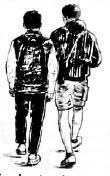
Thomas: Good morning, Tom. May I join you in your game?
Tom : Good morning, Thomas. You are most welcome, my friend. How have you been?
Thomas: I have been fine. Thank you. How about you?
Tom: I am well. It is such a coincidence for us to meet here.
Thomas :I was going to Democratic Hotel but it has become very noisy lately.
Tom :Let us go to a different hotel. I discovered another one around the corner.
Thomas :Where is that? I have never heard of a new hotel in town.
Tom: Let us take a walk there.
Thomas :This place looks nice!
Tom :You are at the right place. It is quiet here and you do not stand the risk of food poisoning. The meals are always fresh.
Waiter : Good morning. Please make your order.
Thomas Tom, could you help me make a choice from this menu?
Tom : Of course, I shall help you. I suggest that you try their boiled potatoes and lamb chops in soy sauce.
Waiter :You will have them shortly. Feel at home.
- What was Tom doing at the beginning of the conversation?
- He was going to a hotel.
- He was playing some sort of game.
- We are not told.
- He was roaming around the streets.
- When you say it is a coincidence, what do you mean?
- Two things happening at the same time without planning.
- Planning for two things to happen at the same time.
- Wandering around before meeting a friend.
- Going to a different hotel without planning.
- Three of the following are true about the newly discovered hotel except?
- The meals gre not stale.
- No risk of food poisoning.
- It is a quiet place to enjoy your meal.
- The meals are expensive.
- When you go to a hotel, you
- study the food and choose the one you love.
- study the menu and then place an order.
- demand to be served.
- request for food to be brought.
- Which of the following polite words has not been used in the conversation?
- You are most welcome.
- Could you help me.
- Good afternoon.
- Feel at home
Read the passage below and then answer questions 6-9.
People are becoming aware of the importance of a clea and green environment every day. We need to keep our environment clean and green. To breathe fresh air, the air needs to be free from pollution. We also need to drink clean water. Contaminated water can make us sick. Fifth June is celebrated as the World Environmental Day to spread awareness all over the world for the protection of the environment. A clean and green environment is important for a healthy life. If we can damage our environment, we can also heal it. However, prevention is better than cure. As part of the environment, we must take steps to protect our environment by planting more and more trees, saving water,saving electricity, maintaining cleanliness not only at home but also on roads and public places. Spreading awareness on the importance of a clean environment should be emphasised since knowledge is power. You and I have a part to play to ensure we live in a clean and green environment.
- What do we learn about contaminated water?
- It is part of the polluted environment.
- It can make us fall sick.
- It is found in our environment.
- It can be avoided by all means.
- In order for us to enjoy a healthy life, we need
- a clean and green environment.
- to eat well and exercise regularly.
- to avoid damaging the environment.
- to prevent before the worst happens.
- Which one among the following steps is not important in the protection of our environment?
- Planting more and more trees.
- Saving electricity and water.
- Maintaining cleanliness only at home.
- Maintaining cleanliness everywhere.
- The best title for the passage above would be
- Importance of a clean environment.
- Prevention is better than cure.
- A clean and fresh environment.
- World Environmental Day Awareness.
Read the poem below and then answer questions 10-12.
Let's celebrate
It's time to celebrate
Jamhuri Day, our freedom gained
A battle for freedom
Fought on Kenyan soil
A history of victory
Celebrations make us one
They make us a nation.
It's time to celebrate
Madaraka Day, our self-governance Day
A battle for self-rule
Fought and won
A history of victory
Celebrations make us one
They make us a nation.
It's time to celebrate
Mashujaa day, our Heroes Day
A noble battle
Fought by heroes and heroines
A history of victory
Celebrations make us one
They make us a nation.
It's time to celebrate
With song and dance
Let stadiums overflow with young and old
Government leaders and invited attire
Celebrations make us one
They make us a nation.
- Who should take part in the celebrations?
- The freedom fighters.
- Everybody of Kenyan origin.
- Our leaders.
- Our heroes and heroines.
- Which of the following national celebrations has not been mentioned?
- Madaraka Day
- Mashujaa Day
- New Year's Day
- Jamhuri Day
- How do national holidays make us one?
- We all come together during the event andenjoy.
- They are held in one nation.
- They are led by the president of our nation.
- Stadiums become full of people.
Read the passage below and then answer questions 13 – 15
A certain community in Kenya has been forced to turn to crop farming to earn a living. Initially, they practised pastoralism. Their food consists of meat and milk. "We love animals very much but we are not able to keep them anymore," they say. Seasons seem to have changed and now the community earns their pay through farming. At first, they made a loss but are currently adapting to the new lifestyle. Due to climate change and lack of pasture, the community makes use of the irrigation schemes to produce food. "We hardly miss something to eat nowadays," one of the elders says. "Our children do not have to worry about school. They attend school every day for we no longer keep shifting." Life has truly changed and for the better.
- What did the community members feed on before the new discovery?
- Various food crops.
- Meat and milk.
- Meat only.
- Cereals and milk.
- How does the community get its food today?
- By using irrigation schemes.
- By buying food from other communities.
- By exchanging animal products.
- By selling various things in the community.
- The best title for the passage above would be
- Food chain change.
- A new way of getting food.
- Lifestyle Climate Change.
- Crop production.
Read the passage below. It contains blank spaces numbered 16-20. For each blank space, choose the best alternative from the given four.
Tina, her twin brother Brian and 16 mother took their breakfast and got ready to walk to the market. They 17 a big basket and 18 shopping bags to carry the goods they 19 buy. On the way to the market, the twins and their mother went to the bank to 20 the money they would use to pay for goods at the market.
| 16 | A. there | B. their | C. they're | D. they'll |
| 17 | A. carried | B. brought | C. bought | D. took |
| 18 | A. any | B. a | C. one | D. some |
| 19 | A. could | B. must | C. should | D. would |
| 20 | A. deposit | B. get | C. withdraw | D. cover |
For question 21-28, choose the alternative that best completes the given sentence.
- I like school. Both the teachers and learners are friendly.
- that
- these
- this
- those
- are Tina's pencils. Do not touch them.
- This
- Some
- That
- Those
- The freedom fighters denied ____ comfort.
- themselves
- theirselves
- them selves
- them
- I have learnt that I swallow food before speaking.
- must
- should
- may
- can
- The teacher taught road safety.
- we
- they
- us
- hers
- This house belongs to them. It is
- theirs
- their
- theres
- thems
- Wamaitha was too intelligent
- for her to bit.
- to be fooled.
- because you could not fool her.
- so as to fool.
- Complete the degree: expensive
- more expensive, most expensive
- expensiver, expensivest
- kind of expensive, most expensive
- expensivest, most expensive
For questions 29 and 30, choose the alternative that means the same as the underlined word(s).
- A person who has a rict to belong to a country.
- loyalty
- patriot
- citizen
- foreigner
- A form of amusement.
- event
- ceremony
- wedding
- entertainment
COMPOSITION
Write an interesting composition starting with the following words.
The day for the celebration came...
MARKING SCHEME
- B
- A
- D
- B
- D
- B
- A
- C
- A
- B
- C
- A
- B
- A
- C
- B
- A
- D
- D
- C
- C
- D
- A
- B
- C
- A
- B
- A
- C
- D
Mathematics Questions and Answers - Grade 5 End Term 1 Exams 2023 Set 2
QUESTIONS
- There were 36960 tree seedlings to be planted. If all of them were planted, how many tree seedlings were planted in words.
- Three hundred and sixty nine and sixty.
- Thirty six thousand nine hundred and sixty.
- Three thousand six hundred and ninety six.
- Thirty six thousand and ninety six.
- Four Grade four learners formed some numbers using 6, 7, 8 and 9.
Which one of the following is the correct order of the numbers in descending order?8679 7896 8976 9687 7869 9786 - 8679, 7896, 8976, 9687, 7869, 9786
- 7869, 7896, 8679, 8976, 9687, 9786
- 9786, 9687, 8976, 8679, 7896, 7869
- 7869, 7869, 8679, 8976, 9679, 9786
- Round off 1645 to the nearest 100.
- 1700
- 1650
- 1600
- 1640
- Winnie, a Grade 5 learner was given the following numbers:
Which of the numbers is divisible by both 2 and 5?- 90
- 88
- 62
- 25
- Work out the difference of 9829 and 6460 by rounding off to the nearest hundreds.
- 16289
- 3369
- 3300
- 3400
- Which type of an angle is more than 90° but less than 180°?
- Reflex angle
- Acute angle
- Obtuse angle
- Right angle
- During national census 983625 people were counted. Work out the place value of digit 9.
- Thousands
- Tens of thousands
- Hundreds of thousands
- Ones
- Grade five learners from Simba Primary School, were work out the common divisors for of 56 and 42 in groups.
Which group got the correct common divisors for both 56 and 42?GROUP A GROUP B GROUP C GROUP D 4 and 7 4 and 8 7 and 14 1 and 3 - GROUP D
- GROUP B
- GROUP C
- GROUP A
- In 2021, a total of 356249 people visited a certain hotel in Mombasa while in 2022, the hotel received a total of 335641 people. How many people visited the hotel in the two years?
- 691880
- 681890
- 681880
- 691890
- During a parent's meeting at a certain school, 74 boxes of water were bought. If each box had 24 bottles of water, how many bottles of water were bought?
- 1776
- 98
- 50
- 1766
- Grade four learners counted the number of lines of symmetry in a rectangle.
AMY → FOUR CHRIS → THREE
WILIAN → ONE SASHA → TWO
Who among the following learners got it correct?- WILIAN
- SASHA
- CHRIS
- AMY
- Work out:
WEEK DAYS
3 4
−. 1 5
_________________- 5 Weeks 2 Days
- 2 Weeks 1 Day
- 1 Week 6 Days
- 4 Weeks 9 Days
Below is a list of items that Mumo bought from Anita's shop. Use it to answer question 13 and 14.
1 KG of sugar@ sh. 180
2kg of wheat flour for sh. 165
1 match box at sh. 6
2kg maize flour for 240
- How much did Mumo pay for the items?
- Sh. Sh. 765
- Sh. 756
- Sh. 1000
- Sh. 591
- If Mumo paid for the items using a sh. 1000 note, how much did she get as the balance?
- Sh. 244
- Sh. 409
- Sh. 500
- Sh. 245
- Lessons at Hamisi primary school start at the time shown below.
What time is it? The time is _____________________- Fifteen minutes to eight.
- Fifteen minutes to seven.
- Fourty five minutes to eight.
- Fourty five minutes to seven
- On Monday Sannai had Y apples. She shared the apples among her 8 friends. How many apples did each friend get?
- 8Y
- 8+Y
- Y − 8
- Y/8
- James was facing East one morning. His friend called him and he made a quarter turn in the clockswise direction and saw his friend. To which direction was his friend?
- South
- North
- East
- West
- What is the GCD OF 24 and 32?
- 96
- 8
- 48
- 32
- During a mathematics practical, learners used a quarter litre container to fill a twenty litre container. How many quarter litre containers were used?
- 5
- 20
- 80
- 4
- In the figure below, show the shaded part as a fraction.
- 0.79
- 21/100
- 79/100
- 0.79
- Write 32/7 as an improper fraction
- 21/7
- 7/23
- 7/21
- 23/7
- A fruit vendor had 87 bananas. He sold the bananas in groups of 7. How many bananas remained if he sold all the groups of seven?
- 7
- 80
- 3
- 84
- Mary's brother is 32 years. Which one of the following shows his age in roman numerals?
- XXLII
- XXII
- XXXII
- XII
- Grade four learners represented a certain number on the abacus as shown below.
Which number is represented on the abacus ?- 34
- 3.04
- 304
- 3.4
- What is the next number in the sequence. 1, 3, 9, 27 _____________
- 81
- 54
- 36
- 63
- A number is divisible by 2 if ___________________
- The last digit is even
- The last digit is odd
- It is divisible by 3
- It is divisible by 10
- Work out:
SH CENTS
320 80
+ 66 40
_______________- Sh.387 120cents
- Sh.387 20cents
- Sh. 386 120cents
- Sh. 386 20cents
- Aron stayed in Arusha for 384 hours. How many days did he stay in Arusha?
- 54 Days
- 384 days
- 24 days
- 16 days
- Using a ruler, measure the length of each line given below

- 6.5cm
- 6cm
- 5.5cm
- 5cm
- The table below shows the number of learners absent from school in a certain week.
How many learners were absent on Friday?DAY TALLY MARKS MONDAY III TUESDAY IIII III WEDNESDAY IIII I THURSDAY IIII FRIDAY IIII IIII III - 23
- 18
- 13
- 4
Kiswahili Questions and Answers - Grade 6 Mid Term 1 Exams 2023 Set 5
Soma kifungu hiki kisha ujibu swali la 1-5.
Tuta na Twita walikuwa wavulana. Walipendana kama chanda na pete. Walisoma katika shule moja.
Ajabu ni kwamba wote walikuwa na umri sawa. Walikuwa wakisoma kuanzia Jumatatu hadi Ijumaa.
Jumamosi na Jumapili walipumzika nyumbani kwao na kufanya kazi za ziada kutoka shuleni. Baada ya
kumaliza kazi za ziada, walipendelea kuenda kucheza.
Siku moja Tuta na Twita waliamua kwenda msituni kuwinda ndege kwa manati. Ilikuwa siku ya
Jumapilii. Walipofika msituni, waliendelea kuwawinda ndege. Waliendelea na mchezo wao hadi masaa ya
adhuhuri. Tuta akamwuliza Twita," Rafiki yangu,tutakula nini? Mimi ninahisi njaa!" Twita akasema "Mimi
nina kiporo ndani ya mfuko wa kaptura yangu. Sina wasiwasi!"
Maswali
- Tuta na Twita walikuwa wavulana ndiko kusema
- walikuwa vijana
- walikuwa watoto wa kiume
- walikuwa duma
- walikuwa wanaume.
- Walipendana kama chanda na pete inamaanisha
- walipendana sana
- walipendana kidogo tu
- walipenda pete na chanda
- walikuwa wapenzi.
- Wote wawili walikuwa na umri sawa. Kumaanisha walikuwa
- pacha
- ndugu
- marika
- kaka.
- Ni yupi aliyehisi njaa walipokuwa msituni?
- Hatujaambiwa
- Twita
- Tuta
- Rafiki.
- Twita alikuwa na kiporo. Hiki ni chakula
- cha nyama
- cha ugali
- kilicholala
- cha msituni.
Soma kifungu kifuatacho kisha ujibu swali la 6-10.
Mama aliniacha nyumbani na mtoto wetu mdogo. Nilimpenda sana mtoto wetu Nurika. Tulicheza na kucheka pamoja. Nilimwimbia wimbo mzuri. Nurika alikuwa mtoto mwenye furaha. Mara nilisikia mlango wa nyumba ukigongwa. Nikaitikia, "karibu!" Nilidhani ni rafiki yangu Sifu aliyekuja kwetu kucheza
nami.
Nilipoufungua mlango, nilimwona mtu mgeni kabisa Akaniuliza, "Mama yako yuko wapi?" Nilimjibu, "Ameenda sokoni." Mgeni aliketi hata kabla nimwambie aketi.Akaniambia:"Mimi ni rafiki ya mama yako. Nitamngoja mpaka aje kutoka sokoni. Nenda dukani ukaniletee soda ninywe nikimsubiri, Nina kiu sana!" Alinipa pesa.Nikakimbia dukani kumletea soda.
Nilipotoka dukani, sikumkuta. Alitoweka na mtoto wetu Nurika. Polisi bado wanamtafuta mama huyo.
Maswali.
- Mwandishi alipoondoka alimwachia nani mtoto?
- Mama yangu
- Mama mgeni
- Nyanya
- Nurika.
- Aliyebisha mlango bila shaka alisema nini?
- Karibu
- Hodi
- Niingie
- Nani yupo?
- Mgeni aliyeingia alikuwa
- mwanamke
- rafiki
- askari
- mwanamume.
- Mgeni alimtuma mwandishi soda ili
- akunywe
- anywe
- akule
- ya kukunywa.
- Kulingana na kisa hiki mgeni alikuwa na tabia gani?
- Mkweli
- Mzalendo
- Mwema
- Mwenye mkono mrefu.
Soma kifungu hiki kisha ujibu maswali 11-15.
Magari yoyote ya kuwabebea abiria huitwa matwana. Katika matwana mna mabasi au kwa umoja basi. zipo matatu au kwa jina jingine ni daladala. Magari yote haya hulipisha nauli ndipo yatoe huduma za usafiri. Anayelipa nauli ili asafiri huitwa abiria. Mahali ambapo magari yote huegeshwa ili yaanze safari tena upya huitwa kituoni au stesheni ya mabasi au kituo cha matwana.
`Anayeendesha gari huitwa dereva. Anayemsaidia dereva kupanga abiria ni utingo. Yeye ndiye
anayepokea nauli. Hulipisha abiria kulingana na mahali wanapoenda iwapo ni mbali au karibu. Matwana
husimama kwa muda mfupi stanini ili kushusha au kubeba abiria. Madereva wanafaa kuyaendesha magari kwa utaratibu mkubwa ili kuzuia ajali.
Maswali
- Magari ya kuwabeba abiria kwa jina maalum ni
- matwana
- matatu
- mabasi
- daladala.
- Malipo anayotozwa abiria ili asafiri ni
- tikiti
- ada
- risiti
- nauli.
- Watu wanaotumia magari kusafiri wanaitwa
- wasafiri
- wafanyikazi
- abiria
- utingo.
- Dereva ni mtu ambaye ________________________________ gari.
- huongoza
- huendesha
- hupeleka
- huchukua
- Ajali nyingi husababishwa na madereva
- wasiomakinika
- wenye utaratibu
- wanaomakinika
- waangalifu.
Jaza mapengo kwa majibu sahihi.
Chakula ___16___ kitamu watu hufurahia. Mimi hupenda chakula ___17___ na ___18___. Sitaki ___19___
chakula ___20___kwa sababu husababisha maradhi ya tumbo
| A | B | C | D | |
| 16. | kikiwa | ikiwa | ukiwa | yakiwa |
| 17. | nzuri | mzuri | tamu | kitamu |
| 18. | kisa | safi | mzuri | nyingi |
| 19. | nile | nikule | kukula | kuikula |
| 20. | chafu | kichafu | mchafu | uchafu |
Chagua jibu mwafaka kulingana na maagizo.
- Kiungo cha kusafisha hewa ni
- maini
- figo
- moyo
- pafu.
- Miti _________________________ ilikatwa ni hii.
- ambao
- ambaye
- ambayo
- ambazo
- Mchezo wa kuvutana kwa kamba ni
- ndondi
- njugwe
- jugwe
- mwereka
- Ukubwa wa nguo ni
- manguo
- guo
- kiguo
- vinguo
- Kitenzi 'cheza' katika hali ya mazoea ni
- hucheza
- amecheza
- hajacheza
- atacheza.
- Kivumishi kionyeshi ni kipi katika sentensi ifuatayo?
Watoto hao watacheza vizuri sana- Sana
- Vizuri
- Hao
- Watoto.
- Kiambishi cha nafsi ya pili katika wingi ni
- yeye
- wewe
- wao
- nyinyi.
- Akifisha sentensi ifuatayo.
Mbona unatembea polepole- !
- ?
- :
- ,
- Chagua jozi ya vitate.
- cheka - chora
- fika - pika
- buda - bunda
- gamba - gumba
- Msimu wa baridi kali ni
- kipupwe
- kiangazi
- vuli
- masika.
INSHA
Mwandikie rafiki yako barua ukimshauri jinsi ya kufaulu katika masomo.
MARKING SCHEME
- B
- A
- C
- B
- C
- B
- B
- A
- B
- D
- A
- D
- C
- B
- A
- A
- D
- B
- A
- B
- D
- C
- B
- B
- A
- C
- D
- B
- C
- A
Creative Arts & Social Studies Questions and Answers - Grade 5 Mid Term 1 Exams 2023 Set 2
ART AND CRAFT
- What are warps in weaving?
- The threads which go over and under the wefts
- The threads that go over and under the warps
- The threads that form the framework of a woven item
- The interlacing of wefts
- What is the name given to a person who moves a puppet?
- Potter
- Marionette
- Painter
- Puppeteer
- Look at the picture below keenly
Which is the most outstanding element of art?- Line
- Shape
- Texture
- Balance
- Which pair of items can be made through weaving?
- Shoes and belt
- Pot and shoes
- Mat and fish traps
- Hat and bowl
- The following are four steps used by grade 4 learners to make a tie and dye pattern on a cloth
- Tie the fabric according to the pattern
- Removing the fabric from the water bath, rinse it to remove the excess dye and untie
- Wash the piece of cloth to remove starch and dirt
- Dip the cloth in the dye bath and leave it for a while
Arrange the steps from the first to the last- i,iv,ii, iii
- iii, i, iv,ii
- iv, ii, i,iii
- iii, ii, iv, i
- What name is given to the part of a letter that goes up?
- Ascender
- Descender
- Body
- Design
- A thin strip of leather is known as
- coil
- adhesive
- raffia
- thong
- A picture making technique that involves cutting and pasting different pictures together to make a pictorial composition is known as
- mosaic
- montage
- collage
- graphic design
- A grade 5 learner was drawing a still life composition by making sure that all the elements and principals of art were well distributed in the drawing. Which principle of art was the grade 5 learner mainly considering while drawing?
- Balance
- Proportion
- Overlapping
- Line
- What is the use of an expandable folder in school?
- Used to store school uniform
- Used to store sharp tools
- Used to store loose papers
- Used to store books
MUSIC
- In which of the following occasions is the Kenyan national anthem not sung?
- Flag raising ceremony
- To soothe a baby to sleep
- During public functions
- If the president attends an event
- One of the following groups includes melodic percussion instruments only.
Which one?- Marimba and piano
- Kayamba and drums
- Violin and guitar
- Flute and trumpet
- A celebration song would most likely be sung ________________________________
- slowly and emotionally
- softly and slowly
- lazily
- loud and fast
- The third verse of the Kenyan national anthem ends with the words _______________________________
- Plenty be found within our borders
- Firm may we stand to defen
- Let all with one accord
- Fill every heart with thanksgiving
- Grade five learners were mentioning elements of music. Which one is wrong?
- Pitch
- Noise
- Dynamics
- Rhythm
- The following are parts of a drum. Which one is not?
- Lace
- Membrane
- Resonator
- Head joint
- A type of song that shows love for one's country is called a ______________________________
- topical song
- lullaby song
- patriotic song
- sacred song
- The technique used to play wind instruments is
- shaking
- blowing
- rubbing
- drumming
- The type of song where different singers of a particular song start and end at different times is called a ________________
- funny song
- round song
- hard song
- action song
- Standing at attention when raising the national flag is a sign of _______________________
- respect
- fear
- confussion
- favou
SOCIAL STUDIES
Study the map of Simba area and answer questions 21-25.
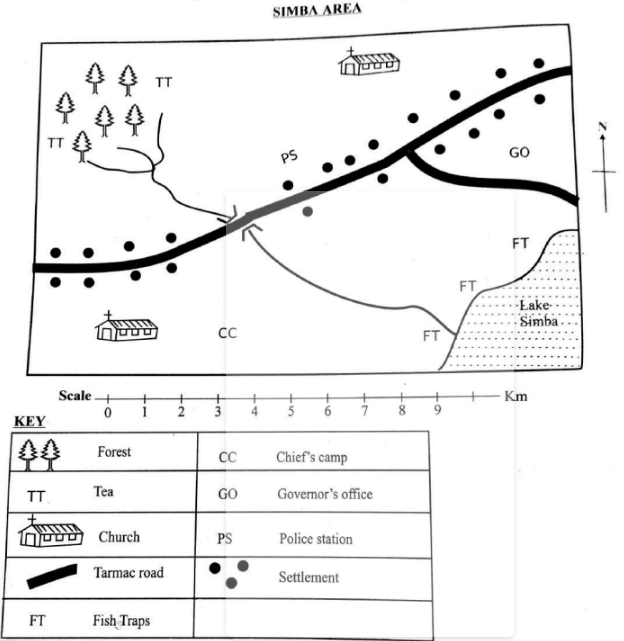
- From the map, what is the main use of Lake Simba?
- Fishing
- Swimming
- Transport
- Irrigation
- Most people in Simba area are
- Christians
- Muslims
- Hindus
- Traditionalists
- The main means of transport in Simba area is
- railway
- road
- water
- air
- The type of settlement found in Simba area is
- scattered
- clustered
- linear
- nucleated
- The elected head of Simba area is a
- Governer
- Chief
- County Commissioner
- President
- Monari the Social Studies teacher for grade 5 asked his learners to identify the key elements of a map. Who did not give the correct answer?
- Joseph - key
- Amos - title
- Joyce - scale
- Hosea - shape
- What is the direction found at Y?
- South East
- South West
- North East
- North West
- Who among the following admnistrators is in charge of discipline in a public school?
- Deputy head teacher
- Senior teacher
- Student leader
- Head teacher
- Below are physical features. Which one is not?
- Mountains
- Valley
- Plateaus
- Vasco da Gama pillar
Use the map of Kenya below to answer questions 30-33
- Which of these rivers drains its water into the water body marked M?
- River Turkwel
- River Athi
- River Nzoia
- River Yala
- The lake marked S is called
- L. Turkana
- L. Victoria
- L. Nakuru
- L. Baringo
- The dotted physical feature marked P is called
- Rift valley
- the plateau
- the highlands
- the plains
- The country that neighbours Kenya to the West marked X is calle
- Tanzania
- Uganda
- Somalia
- Ethiopia
- Grade five teacher at Mema primary school asked his learners to name Historic built environments. Who among them did not give the correct answer?
- Samuel - Cultural centres
- Dennis - Historic buildings
- Ken Game reserves
- Karen - Museums
- Who among the following is not a member of the County Assembly?
- Members of the County Assembly
- Speaker of the County Assembly
- Senator
- Nominated members of the County Assembly
C.R.E
- According to Genesis, God took how many days to create the earth?
- 6
- 7
- 1
- 5
- The wisemen who came from the East brought gifts to Jesus. Which one was not one of the gifts?
- Myrrh
- Gold
- Silver
- Frankincense
- During the time of Noah, God punished people using
- Floods
- drought
- fire
- famine
- When God asked Abraham to move from Haran to Canaan, Abraham moved without complaining because he
- had faith in God
- knew how fertile Cannaan was
- wanted to move away from Haran
- knew Canaan as land of honey and milk
- Grade 5 CRE teacher asked the learners to identify the fruits of the Holy spirit. Which one is not?
- Faithfulness
- Love
- Healing
- Humility
- The parable of the friend at midnight teaches Christians to
- be persistent in prayer
- seek help
- love their neighbours
- seek the kingdom of God
- In traditional societies people worshiped in special places called
- synagogue
- shrines
- temples
- churches
- When Jesus fed the five thousands people, where did he get food from?
- Disciples
- A farm
- A boy
- Market
- On which mountain did Elijah contest with the prophets of Baal?
- Sinai
- Moriah
- Carmel
- Horeb
- Which commandment has a promise among the ten commandments?
- 5th
- 6th
- 7th
- 8th
- Which rite of passage marks the end of childhood and the beginning of adulthood?
- Marriage
- Birth
- Initiation
- Death
- The following are changes that take place during adolescence. Which one is not?
- Hips broaden in girls
- Voice breaks in girls
- Growing and enlargement of breast in girls
- Attraction to the opposite sex
- Jane picked sh. 500 note while sweeping the class. As a Christian, what should she do?
- Use the money to buy lunch
- Take the money and give it as offering in church
- Give it to the teacher
- Keep it and keep quiet
- The first miracle of Jesus was
- feeding five thousand people
- walking on water
- raising Lazarus
- changing water into wine
- Who helped Jesus carry the cross to Calvary?
- Joseph of Arimathea
- Simon of Cyrene
- Peter
- John
I.R.E
- Which of the following surahs must be recited in every prayer?
- Fatiha
- Naas
- Falaq
- Maum
- Which surah wants Muslims to pray and sacrifice to Allah alone?
- Ikhlas
- Fatiha
- Naas
- Kauthar
- Learners of Grade 4 were asked by their teacher to name the surah that encourages kindness to orphans. Who among them was right?
- Maimuna : Fatiha
- Zakaria : Kauthar
- Zulekha : Maun
- Zakia : Asr
- Who were the custodians of the Kaabah according to surah Al-Quraysh?
- The Arabs
- The Quraysh
- The Bedouins
- The Muslims
- Which one of the following surahs narrates the episode of the elephants?
- Fiil
- Asr
- Kauthar
- Ikhlas
- Which one of the following terms refers to the fear of Allah?
- Iman
- Tawakkul
- Ihsaan
- Taqwa
- Grade 5 learners were asked to name the Governor of Yemen who wanted to destroy the Kaabah. Who among them was correct?
- Shakira : Abu Sufyan
- Halima : Abu Talib
- Jabali : Najash
- Harrow : Abraha
- The sayings of the prophet (SAW) are referred to as
- Hadith
- Sunnah
- Halal
- Mubah
- Which Holy book was revealed to prophet Muhammad (SAW)?
- Zabur
- Qur'an
- Taurat
- Injil
- How many days did Allah take to create the world and the universe?
- Seven
- Eight
- Five
- Six
- Which attribute of Allah means that He is the creator?
- Al-Aziz
- Al-Ghaffur
- Al-Khaaliq
- Al-Qudus
- Which fardh prayer is performed after sunset?
- Maghrib
- Dhuhr
- Asr
- Subh
- Who among the following is referred to as the mother of all people?
- Hawa
- Amina
- Maryam
- Zulekha
- The prophet of Allah who was swallowed by a whale was
- Ayub
- Hud
- Yunus
- Lut
- Which of the following sunnah prayers is performed only in the month of Ramadhan?
- Witr
- Taraweh
- Dhuha
- Istisqai
MARKING SCHEME
ART
- C
- D
- A
- C
- B
- A
- D
- B
- A
- C
MUSIC
- B
- A
- D
- D
- B
- D
- C
- B
- B
- A
SOCIAL
- A
- A
- B
- C
- A
- D
- A
- A
- D
- B
- B
- A
- B
- C
- C
C.R.E
- A
- C
- A
- A
- C
- A
- B
- C
- C
- A
- C
- B
- C
- D
- B
I.R.E
- A
- D
- C
- B
- A
- D
- D
- A
- B
- D
- C
- A
- A
- C
- B




